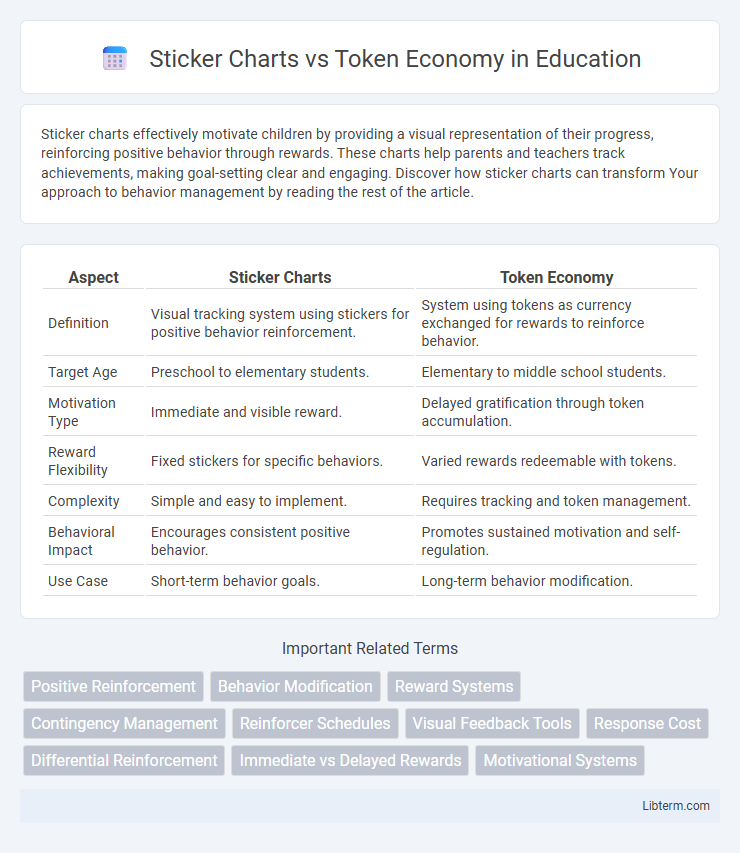Sticker charts effectively motivate children by providing a visual representation of their progress, reinforcing positive behavior through rewards. These charts help parents and teachers track achievements, making goal-setting clear and engaging. Discover how sticker charts can transform Your approach to behavior management by reading the rest of the article.
Table of Comparison
| Aspect | Sticker Charts | Token Economy |
|---|---|---|
| Definition | Visual tracking system using stickers for positive behavior reinforcement. | System using tokens as currency exchanged for rewards to reinforce behavior. |
| Target Age | Preschool to elementary students. | Elementary to middle school students. |
| Motivation Type | Immediate and visible reward. | Delayed gratification through token accumulation. |
| Reward Flexibility | Fixed stickers for specific behaviors. | Varied rewards redeemable with tokens. |
| Complexity | Simple and easy to implement. | Requires tracking and token management. |
| Behavioral Impact | Encourages consistent positive behavior. | Promotes sustained motivation and self-regulation. |
| Use Case | Short-term behavior goals. | Long-term behavior modification. |
Introduction to Behavioral Reinforcement Systems
Sticker charts and token economy systems are effective behavioral reinforcement tools used to increase positive behaviors by providing immediate visual or tangible rewards. Sticker charts offer simple, non-monetary incentives through stickers placed on a chart to track progress, while token economies use tokens exchangeable for desired rewards, promoting sustained motivation. Both systems leverage principles of operant conditioning to reinforce targeted behaviors in educational, clinical, and home settings.
What Are Sticker Charts?
Sticker charts are behavior management tools used primarily in educational settings to reinforce positive actions and accomplishments through visual rewards. Each sticker represents a specific achievement or completed task, motivating children by providing immediate, tangible acknowledgment of their progress. This method leverages visual cues and goal-setting to encourage consistent behavior, making it a popular alternative to token economies.
What Is a Token Economy?
A token economy is a behavior management system that uses tokens as symbolic rewards exchanged for desired items or privileges, promoting motivation and positive reinforcement. Unlike sticker charts that track progress visually, token economies provide a flexible and scalable method for reinforcing a wide range of target behaviors in educational, therapeutic, and organizational settings. This system leverages operant conditioning principles, enhancing behavioral outcomes by allowing individuals to accumulate and redeem tokens for meaningful reinforcers.
Key Differences Between Sticker Charts and Token Economy
Sticker charts involve children earning stickers for specific behaviors, providing immediate visual reinforcement that is simple and easy to track. Token economy systems use tokens or points as a form of currency that can be exchanged for various rewards, promoting more complex and flexible behavior management. The key difference lies in the immediacy and simplicity of sticker charts versus the broader motivational potential and adaptability of token economies.
Benefits of Sticker Charts for Behavior Management
Sticker charts enhance behavior management by providing a clear visual representation of progress, motivating children through tangible rewards. They foster positive reinforcement, encouraging consistent good behavior and promoting goal-setting skills. Unlike token economies, sticker charts are simple to implement and easily understood by young children, making them effective for early behavior modification.
Advantages of Token Economy Systems
Token economy systems offer greater flexibility and scalability compared to sticker charts by allowing the exchange of tokens for a variety of rewards tailored to individual preferences. These systems promote consistent motivation and reinforce target behaviors across different settings, enhancing long-term behavioral change. Token economies also facilitate precise tracking and quantification of progress, empowering caregivers and educators with effective behavior management tools.
Limitations of Sticker Charts
Sticker charts often face limitations such as decreased motivational impact as children outgrow the novelty, leading to reduced long-term effectiveness. They provide limited flexibility in reinforcing complex behaviors compared to a token economy, which allows for a broader range of rewards and customizable reinforcement schedules. Additionally, sticker charts may not adequately address intrinsic motivation, relying heavily on external rewards that can diminish internal drive.
Challenges of Implementing Token Economy
Implementing a token economy presents challenges such as maintaining consistent reinforcement schedules and ensuring tokens retain perceived value over time to motivate behavior effectively. Managing the complexity of tracking token exchange rates and preventing token inflation requires careful planning and ongoing adjustments. Additionally, individual differences in token preference and the potential for decreased intrinsic motivation can undermine the system's long-term effectiveness.
Choosing the Right System: Factors to Consider
Choosing between sticker charts and token economy systems depends on factors like the child's age, motivation style, and behavioral goals; sticker charts offer visual simplicity suited for younger children, while token economies provide more flexibility and complex reinforcement options ideal for older children or multiple behaviors. Consider the ease of implementation and consistency; sticker charts require minimal resources and are straightforward, whereas token economies may need tangible tokens and a structured exchange system. Effectiveness also hinges on individual preferences and desired outcomes, making it crucial to tailor the system to the child's unique needs and the specific behaviors targeted.
Practical Tips for Successful Implementation
Sticker charts motivate children by providing visual and tangible rewards that track progress on specific tasks, making goal-setting clear and attainable. Token economy systems use tokens as generalized reinforcers exchangeable for various rewards, promoting sustained behavior change across multiple settings. For successful implementation, consistently define target behaviors, establish clear criteria for earning stickers or tokens, and ensure immediate reward delivery to maintain motivation and reinforce positive habits effectively.
Sticker Charts Infographic

 libterm.com
libterm.com